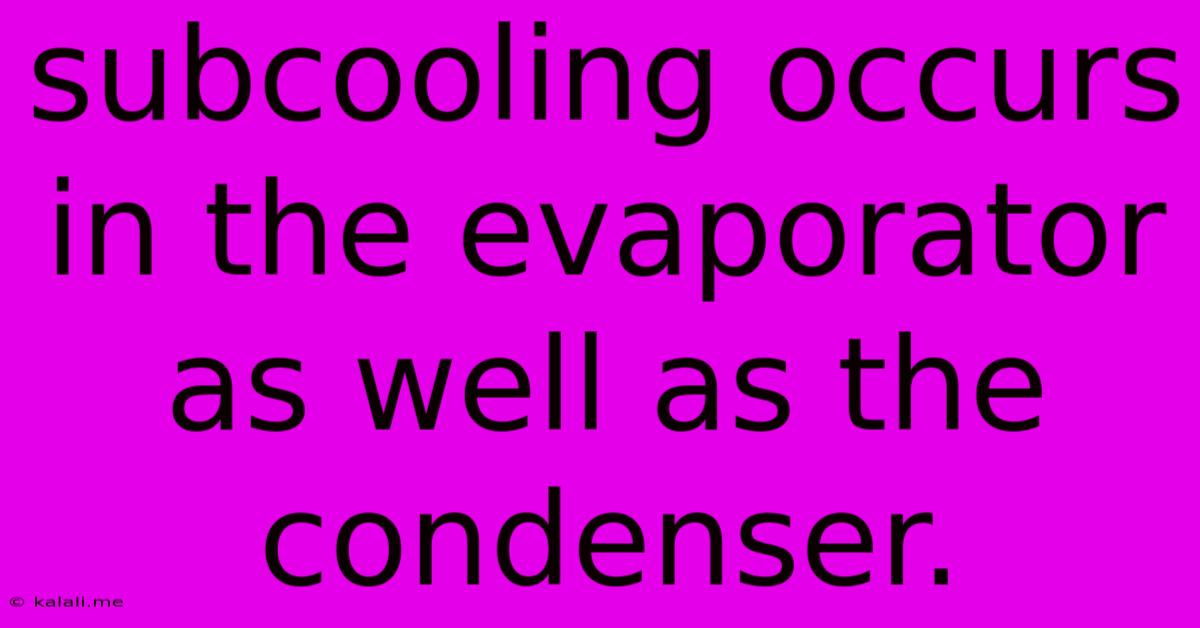Subcooling Occurs In The Evaporator As Well As The Condenser.
Kalali
Jun 16, 2025 · 3 min read

Table of Contents
Subcooling: A Deeper Dive into Evaporator and Condenser Performance
Subcooling, a crucial thermodynamic process, occurs in both the evaporator and condenser of refrigeration cycles. While commonly associated with the condenser, understanding its role in the evaporator reveals important insights into optimizing system efficiency and performance. This article delves into the mechanics of subcooling in both components, explaining its significance and impact on overall system operation.
What is Subcooling?
Subcooling refers to the process of cooling a refrigerant below its saturation temperature at a given pressure. In simpler terms, it's the process of further cooling a liquid refrigerant that is already liquid. This extra cooling enhances efficiency and reduces potential problems associated with vapor entering the system where it shouldn't. The degree of subcooling is measured in degrees Celsius or Fahrenheit.
Subcooling in the Condenser:
The condenser's primary role is to convert high-pressure, high-temperature refrigerant vapor into a high-pressure, saturated liquid. Subcooling in the condenser is a desirable phenomenon. After the refrigerant has completely condensed, further cooling reduces the volume of liquid refrigerant and increases the amount of heat the system can absorb in the evaporator. This leads to:
- Improved System Efficiency: Less energy is needed to vaporize the cooler liquid refrigerant in the evaporator.
- Reduced Liquid Slugging: Subcooling minimizes the risk of liquid refrigerant entering the compressor, a condition known as liquid slugging, which can severely damage the compressor.
- Enhanced Refrigerant Control: Precise subcooling helps in better refrigerant flow control throughout the refrigeration cycle.
- Optimized Heat Transfer: The lower temperature of the subcooled liquid enhances heat transfer in the evaporator.
Subcooling in the Evaporator:
While less commonly discussed, subcooling can also occur in the evaporator, although it's generally undesirable. This situation arises when the refrigerant doesn't fully vaporize before leaving the evaporator. Several factors contribute to evaporator subcooling:
- Insufficient Evaporator Size: An undersized evaporator may not provide enough surface area for complete vaporization.
- Restricted Flow: Obstructions or restrictions in the refrigerant lines can hinder proper vaporization.
- Low Refrigerant Charge: Insufficient refrigerant charge limits the amount of refrigerant available for vaporization.
- Uneven Heat Transfer: Non-uniform heat distribution across the evaporator coil can lead to incomplete vaporization in certain areas.
Consequences of Evaporator Subcooling:
Evaporator subcooling reduces the system's cooling capacity and efficiency. The presence of liquid refrigerant in the suction line reduces the amount of vapor available to absorb heat, resulting in:
- Reduced Cooling Capacity: The system fails to reach the desired cooling temperature.
- Lower Coefficient of Performance (COP): The system consumes more energy for the same amount of cooling.
- Increased Compressor Wear: The presence of liquid refrigerant can lead to increased compressor wear and potential damage.
Optimizing Subcooling in Both Components:
Efficient refrigeration system operation requires careful management of subcooling in both the condenser and evaporator. Proper condenser design ensures sufficient subcooling, while proper evaporator sizing, refrigerant charge, and flow control prevent evaporator subcooling. Regular maintenance, including cleaning and inspecting components, contributes to optimal system performance and prevents issues related to subcooling.
Conclusion:
Subcooling, while a beneficial process in the condenser, becomes detrimental if it occurs in the evaporator. Understanding the factors influencing subcooling in both components is crucial for optimizing refrigeration system efficiency and longevity. Proper design, installation, and maintenance are key to maintaining the correct balance and ensuring optimal performance. By addressing the potential causes of subcooling in the evaporator and ensuring adequate subcooling in the condenser, refrigeration systems can achieve peak efficiency and reliability.
Latest Posts
Latest Posts
-
How To Create Clickable Image In Html
Jun 16, 2025
-
What Are The Factors Of 121
Jun 16, 2025
-
What Is A Theme Of The Passage
Jun 16, 2025
-
A Company That Provides Access To The Internet
Jun 16, 2025
-
Which Word Is Closest In Meaning To The Underlined Word
Jun 16, 2025
Related Post
Thank you for visiting our website which covers about Subcooling Occurs In The Evaporator As Well As The Condenser. . We hope the information provided has been useful to you. Feel free to contact us if you have any questions or need further assistance. See you next time and don't miss to bookmark.